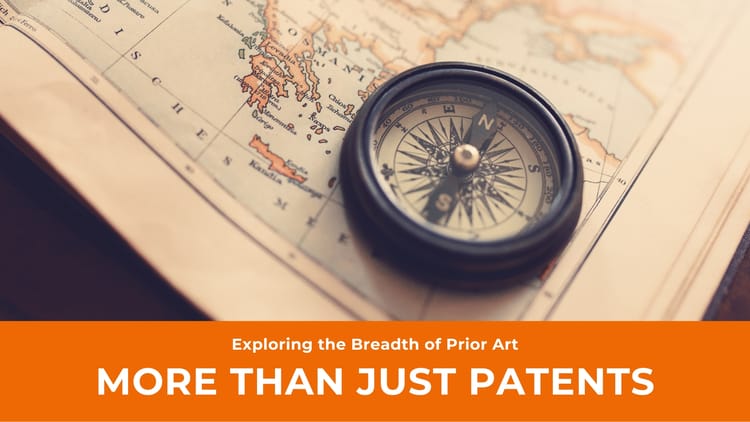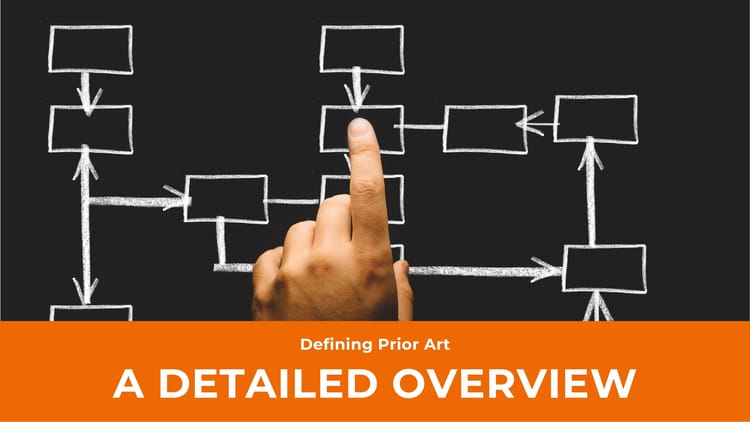Prior Art in Patent Law: How to Protect Your Innovation?
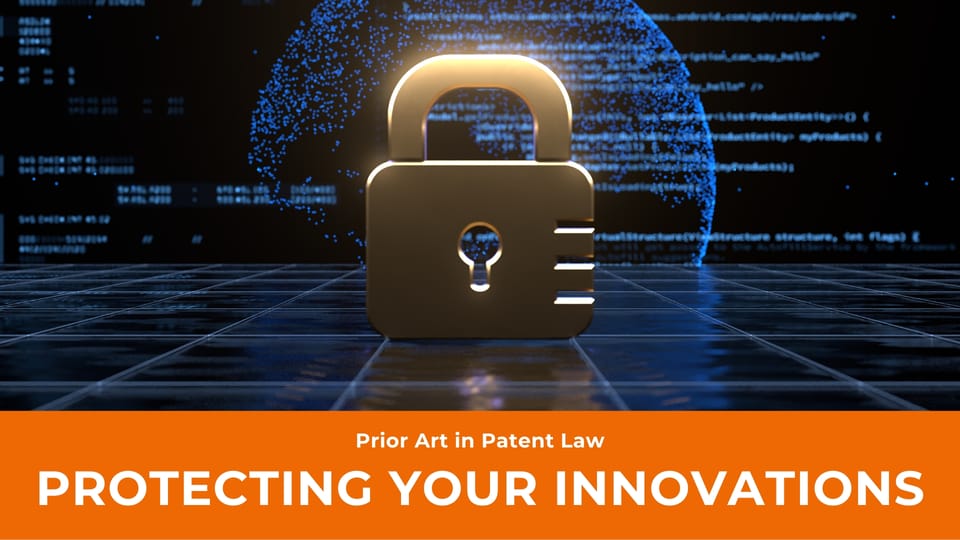
Introduction
In the intricate world of intellectual property, grasping the nuances of prior art is more than just a legal requirement; it's a strategic imperative for anyone looking to protect their innovations. Here’s the deal: the concept of prior art stands at the core of patent law, serving as a crucial determinant in the patentability of new inventions. Its significance cannot be overstated, as it often decides the fate of patent applications and the outcome of patent litigation.
In this comprehensive exploration, we will dive deep into the role of prior art within the realm of patent law. We'll unpack its complexities, illuminate its impact on the patenting process, and provide practical strategies for navigating these often murky waters. This isn't just about understanding a legal concept; it's about arming innovators with the knowledge to safeguard their creative and commercial interests effectively.
In the following sections, we'll start with the basics of prior art, clarifying its definition and scope. Then, we'll delve into its critical role in determining patentability and how it influences the patent application process. We'll also tackle prior art in the context of patent litigation, providing insights into how it can be a game-changer in legal disputes. Finally, we'll offer strategic approaches for innovators and legal professionals, helping them not just navigate but master the complexities of prior art in their patent endeavors.
The Fundamentals of Prior Art in Patent Law
To navigate the landscape of patent law effectively, one must first understand the bedrock upon which it is built: prior art. This section will clarify prior art's legal definition and scope, provide a brief historical context, and underscore its importance in determining patentability.
Defining Prior Art
Prior art refers to any publicly available information before a particular date that might be relevant to a patent's claims of novelty and inventiveness. This includes anything from previously issued patents and published applications to articles, books, presentations, and even products or technologies. Geographical boundaries don't restrict prior art; a publication or invention in one country can be considered prior art in another. If it's known to the public in any form, it's prior art.
Historical Context
Tracing the evolution of prior art offers insight into its current role in patent law. The concept has been part of patent legislation since the inception of modern patent systems, evolving to adapt to technological advancements and changing perceptions of innovation. For instance, the 19th and early 20th centuries saw a relatively narrow view of prior art, primarily focused on existing patents. However, as technology and information dissemination methods advanced, the scope of prior art expanded significantly.
Importance in Patentability
Understanding prior art is critical in determining an invention’s patentability, precisely its novelty and non-obviousness. An invention is novel if it's not already disclosed in the body of existing prior art. It’s deemed non-obvious if, to a person skilled in the relevant field, the invention is not an evident step over what's already known. This is where prior art becomes pivotal; it sets the benchmark against these criteria.
- Novelty: If prior art already discloses an invention, it cannot be patented. This ensures that patents are granted only for genuinely new inventions.
- Non-obviousness: The invention must demonstrate an inventive step beyond the existing body of knowledge. Prior art serves as a reference point for evaluating this aspect.
Identifying Prior Art
Identifying prior art is a fundamental step in the patenting process, shaping the course of patent applications and their legal fortitude. This section will explore the varied sources of prior art, address the inherent challenges in its identification, and offer techniques for conducting effective searches.
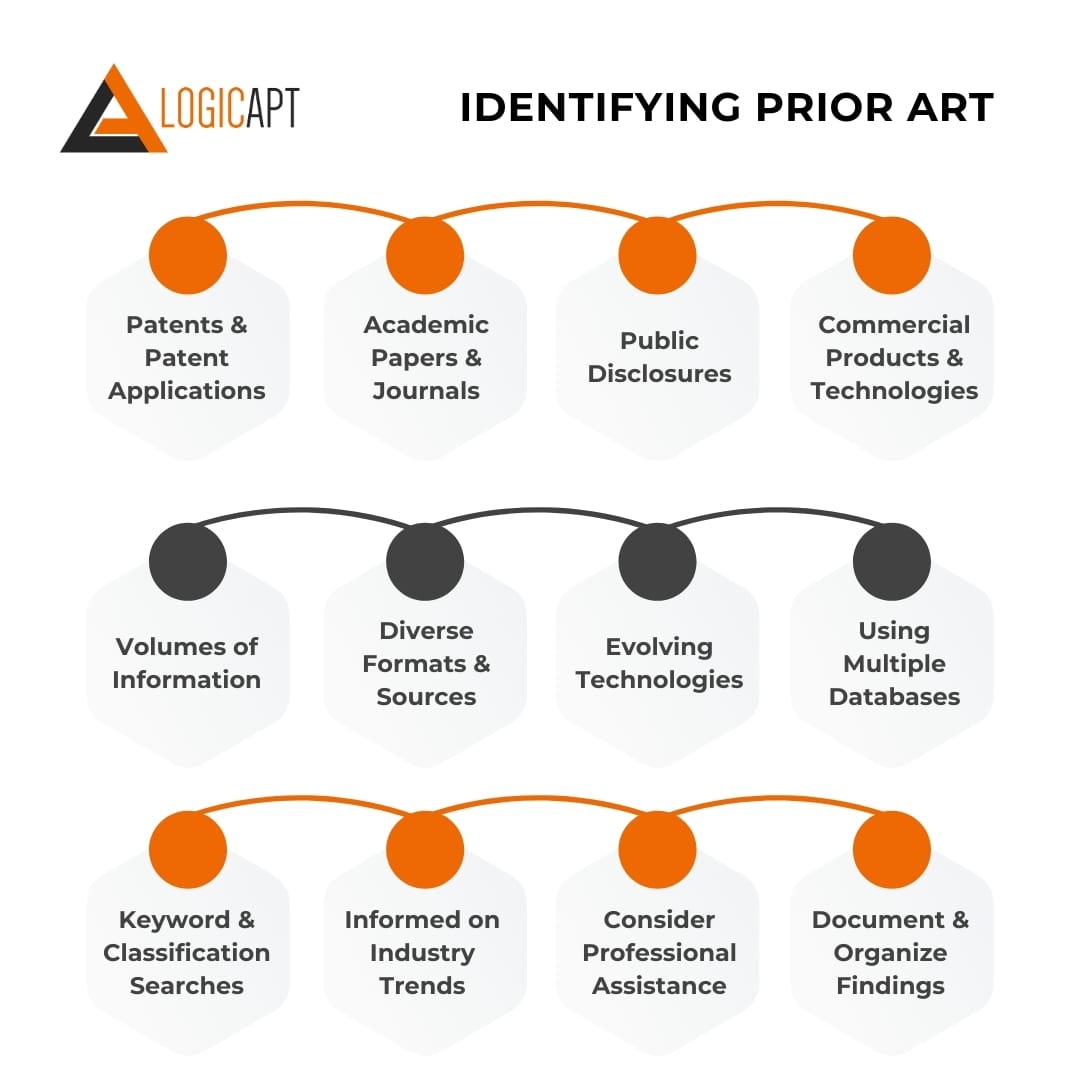
Sources of Prior Art
Prior art comes from various sources, each contributing to the vast puzzle of existing knowledge. Here’s a look at some key sources:
- Patents and Patent Applications: Existing and public patent applications are primary sources. They are comprehensive, containing detailed descriptions of inventions, and are readily accessible through various patent databases globally.
- Academic Papers and Journals: Scholarly articles often detail new research and innovations, serving as a rich technical and scientific information source.
- Public Disclosures: This includes any public presentation, product launch, trade show demonstration, or even online content like blogs and videos that reveal aspects of an invention.
- Commercial Products and Technologies: Existing products and technologies in the market can also constitute prior art if they embody the invention.
Challenges in Identification
The path to identifying relevant prior art is fraught with challenges:
- Volume of Information: The sheer amount of available information can be overwhelming, making it challenging to sift through and identify pertinent prior art.
- Diverse Formats and Sources: Prior art is not limited to patents; it encompasses various formats and sources, requiring searches beyond traditional patent databases.
- Evolving Technologies: Rapid technological advancements mean that what constitutes prior art constantly expands and evolves.
Techniques for Effective Searches
Conducting thorough prior art searches demands a structured approach:
- Use Multiple Databases: Utilize various patent databases like the USPTO, EPO, WIPO, and others, alongside academic and industry-specific databases.
- Keyword and Classification Searches: Develop a list of relevant keywords and use patent classification systems to help narrow down search results.
- Stay Informed on Industry Trends: Keeping abreast of current trends and developments in your field can guide your search toward relevant areas.
- Consider Professional Assistance: Sometimes, the complexity of the search may warrant the expertise of professional search firms or patent attorneys.
- Document and Organize Findings: Maintain a detailed record of your searches, including where and what you found. This documentation can be crucial during the patent application process and potential litigation.
Prior Art and Patent Application
Navigating the patent application process with an acute awareness of prior art is essential for securing robust patent protection. This section delves into crafting patent claims with prior art in mind, understanding its role in the patent examination process, and developing effective strategies to overcome rejections based on prior art.
Drafting Patent Claims
The drafting of patent claims is an art form that requires a delicate balance between breadth and specificity, especially in light of existing prior art:
- Broad vs. Narrow Claims: Claims should be broad enough to cover the invention comprehensively but not so broad that they encompass prior art. Striking this balance is vital.
- Informed by Prior Art: A thorough understanding of relevant prior art guides the drafting process, helping to define the unique aspects of your invention and avoid overstepping into known territory.
- Clear and Concise Language: The clarity of language in claims is crucial. Ambiguities can lead to overlaps with prior art and pose issues during examination.
Navigating the Application Process
Understanding the role of prior art during patent examination is critical:
- Examiner's Search for Prior Art: Patent examiners conduct their prior art searches to assess the novelty and non-obviousness of the claimed invention.
- The Role of Prior Art in Examination: The examiner will compare your claims against the identified prior art. This comparison determines if your invention is sufficiently distinct from what's already known.
- Citing Prior Art: Applicants are often required to disclose known prior art. This transparency can strengthen the credibility of your application.
Overcoming Rejections
Facing rejections based on prior art is not uncommon, but there are strategies to address them effectively:
- Analyzing the Rejection: Carefully review the cited prior art and the reasons for rejection. Understanding the examiner's perspective is the first step in formulating a response.
- Amending Claims: In many cases, amending your claims to more clearly distinguish your invention from the cited prior art can overcome the rejection.
- Argumentation: If amending claims isn’t viable, constructing a robust argument that demonstrates your invention is novel and non-obvious over the cited prior art is essential.
- Continuation Applications: If necessary, filing a continuation application with refined claims can be a strategic move to secure patent protection.
Prior Art in Patent Litigation
Prior art plays a pivotal role in patent litigation, often becoming the fulcrum on which cases turn. This section explores its influence in patent infringement cases and scenarios where it can invalidate patents. It also examines real-life case studies where prior art was a decisive factor.
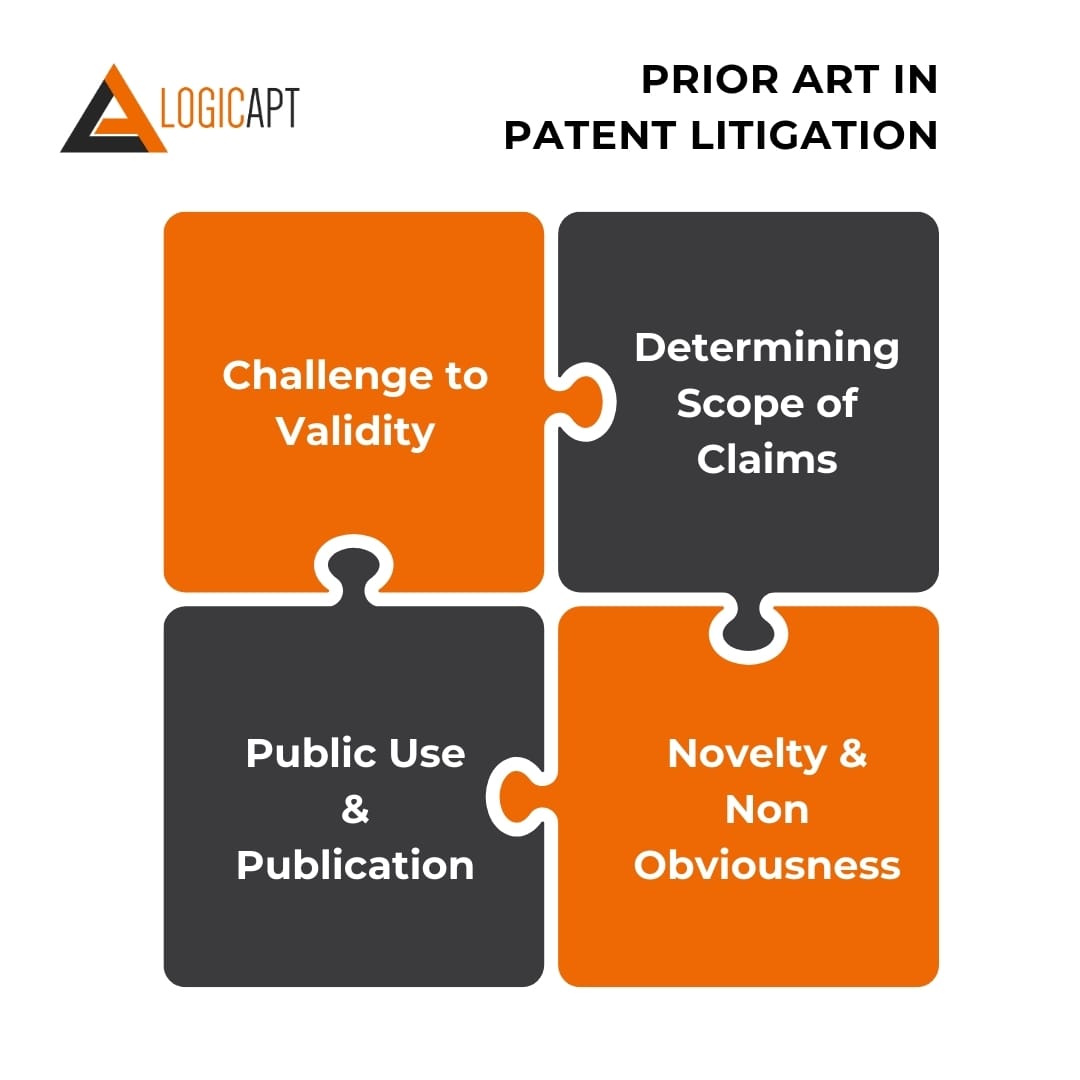
Role in Infringement Cases
In patent infringement litigation, prior art is frequently at the heart of the dispute:
- Challenge to Validity: Defendants often use prior art to challenge the validity of the plaintiff's patent. They can undermine the infringement claim if they prove that the patent should not have been granted due to existing prior art.
- Determining Scope of Claims: Prior art is also used to interpret the scope of the patent claims. Understanding the prior art landscape at the time of the invention can help define how broadly or narrowly the claims should be read.
Invalidating Patents with Prior Art
Prior art can be a powerful tool to invalidate patents:
- Novelty and Non-obviousness: The most common grounds for invalidation are lack of novelty or non-obviousness. Demonstrating that the patented invention was already known or obvious in light of prior art can invalidate the patent.
- Public Use and Publication: Evidence of public use, sale, or publication of the invention before the patent filing can also be grounds for invalidation.
Case Studies
Examining real-life cases offers valuable insights into the role of prior art in litigation:
- Apple vs. Samsung: In this high-profile case, prior art played a significant role. Samsung used prior art to argue that some of Apple's patent claims were invalid because similar designs and technologies already existed.
- KSR International Co. vs. Teleflex Inc.: This landmark Supreme Court case changed how non-obviousness is evaluated. The court’s decision hinged on an expansive view of prior art, making it easier to invalidate patents because the claimed innovations are apparent.
- Eolas Technologies Inc. vs. Microsoft Corporation: In this case, Microsoft successfully invalidated Eolas' patent by presenting prior art that predated the patent, proving that the idea was not novel.
International Perspectives on Prior Art
Navigating the complex landscape of prior art becomes even more intricate when viewed through the lens of international patent law. Different countries have varying approaches to handling prior art, impacting global patent strategies significantly. This section compares these international differences and suggests strategies for managing prior art in a global context.
Comparative Analysis
Different countries have distinct legal frameworks and interpretations when it comes to prior art:
- United States: The U.S. operates under a 'first-to-file' system, with a unique approach to what constitutes prior art, including a grace period for inventors regarding their disclosures.
- European Union: The European patent system is known for its stringent approach to prior art. It follows the 'absolute novelty' standard, where public disclosure can invalidate a patent before filing.
- Japan and China: These countries have specific nuances in their prior art treatment, often incorporating Western and Eastern legal philosophies in their patent laws.
Understanding these variations is crucial for inventors and companies operating internationally. What is considered prior art in one jurisdiction may not be viewed similarly in another, affecting inventions' patentability and defense strategies.
Global Patent Strategies
For businesses and inventors navigating the international patent landscape, a well-thought-out global strategy is essential:
- Conduct International Prior Art Searches: Given the global nature of prior art, comprehensive searches should include databases and sources from key markets worldwide.
- Tailor Applications to Specific Jurisdictions: Be aware of the specific prior art rules in each jurisdiction where you seek patent protection. Customize patent applications to meet these varying requirements.
- Stay Informed on International Law Developments: Laws and guidelines regarding prior art are continually evolving. Keeping abreast of these changes is crucial for maintaining robust patent protection globally.
- Seek Expert Guidance: Collaborating with legal experts specializing in international patent law can provide invaluable insights and strategies for effectively managing prior art issues across different jurisdictions.
Advanced Topics in Prior Art
The landscape of prior art is continuously evolving, particularly with the advent of digital media and the application of artificial intelligence in legal research. In this section, we will delve into these advanced topics, examining how non-traditional sources are becoming increasingly significant in prior art searches and the transformative impact of AI on this critical process.
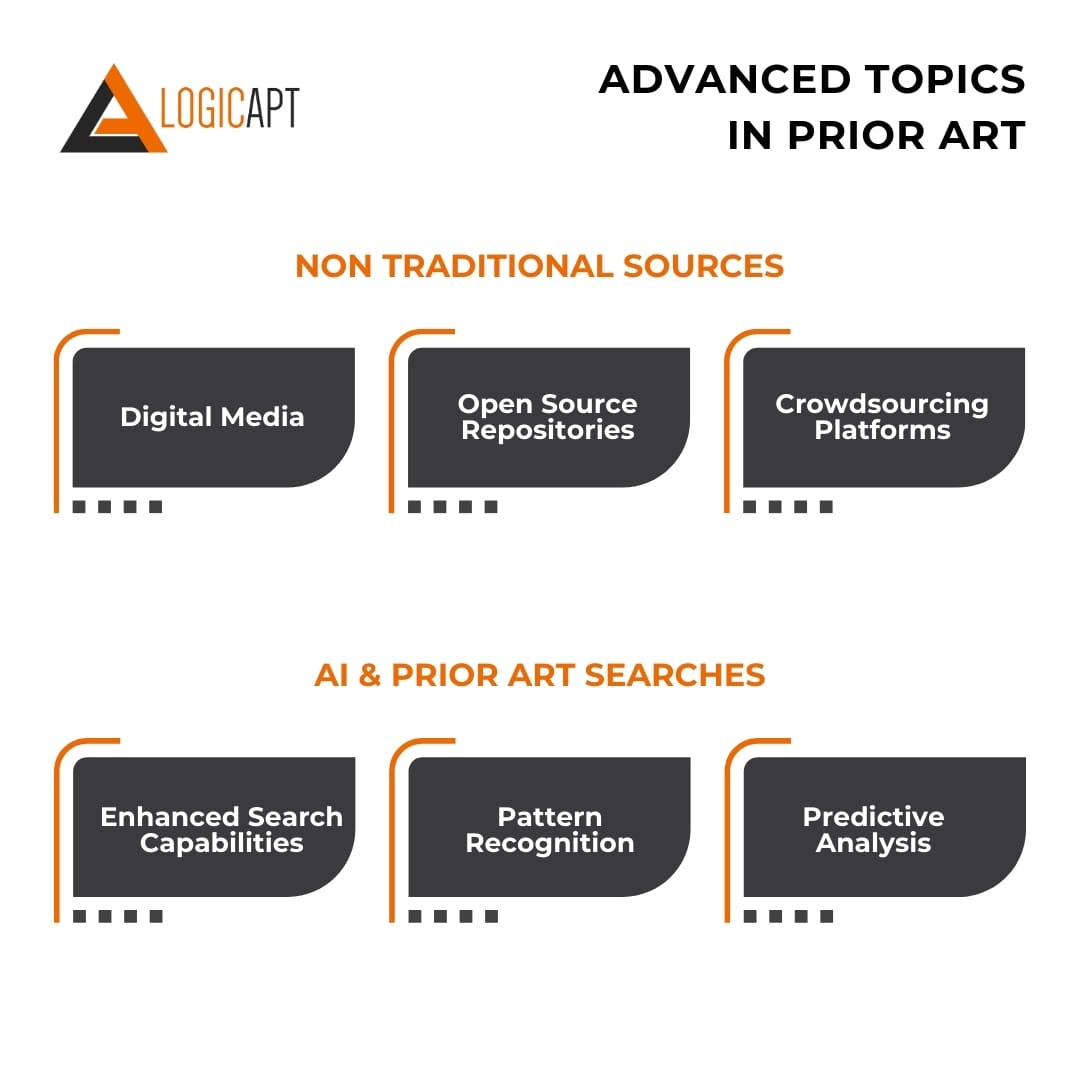
Non-Traditional Sources
The digital age has ushered in a plethora of unconventional sources that are now considered as potential prior art:
- Digital Media: Platforms like social media, blogs, and online forums have become fertile grounds for prior art. An offhand comment or a detailed blog post could potentially disclose an invention, impacting its patentability.
- Open Source Repositories: Software and inventions shared in open source repositories are often overlooked but can constitute significant prior art, especially in the tech industry.
- Crowdsourcing Platforms: Ideas and concepts shared on crowdfunding platforms or collaborative innovation networks may also be considered prior art.
Understanding the implications of these non-traditional sources is crucial for today’s inventors and patent professionals, who must navigate not only traditional scientific journals and patent databases but also the vast expanse of the digital world.
AI and Prior Art Searches
The integration of artificial intelligence into the process of identifying and managing prior art is revolutionizing this arena:
- Enhanced Search Capabilities: AI algorithms can sift through enormous datasets, identifying relevant prior art more efficiently than traditional search methods.
- Pattern Recognition: AI can recognize patterns and connections that might be missed by human researchers, offering a more comprehensive analysis of potential prior art.
- Predictive Analytics: Advanced AI systems are beginning to offer predictive insights, suggesting how certain types of prior art influence patentability and litigation outcomes.
However, this reliance on AI also introduces new challenges:
- Dependence on Algorithms: There’s a risk of becoming overly reliant on AI, potentially overlooking critical nuances that a human expert might catch.
- Bias and Accuracy Concerns: AI systems are only as good as the data they are trained on, raising concerns about inherent biases or inaccuracies in their outputs.
Best Practices and Strategies for Innovators
For innovators and patent professionals, proactive prior art management is crucial for securing patents and maintaining their validity and strength throughout the patent's lifecycle. This section provides best practices and strategies for effective prior art management, building a robust patent portfolio, and navigating collaboration complexities in prior art.
Proactive Prior Art Management
Effective prior art management involves a proactive approach throughout the various stages of a patent's lifecycle:
- Early and Comprehensive Searches: Conduct thorough prior art searches early in the development process to assess the novelty of your invention and guide its development away from known solutions.
- Ongoing Monitoring: Continuously monitor new publications and patents to stay informed about relevant developments in your field.
- Document Development Process: Keep detailed records of your invention’s development process, noting how it differs from prior art. This documentation can be invaluable in defending the novelty of your invention.
Building a Strong Patent Portfolio
A robust patent portfolio can withstand prior art challenges:
- Diversify Your Portfolio: Include a mix of broad and narrow patents. Broad patents offer comprehensive protection, while narrow patents can be more defensible against prior art challenges.
- Regular Portfolio Reviews: Periodically review your patent portfolio to ensure it aligns with current industry standards and technological advancements.
- Quality Over Quantity: Focus on securing strong, well-researched patents rather than amassing many weaker ones.
Collaboration and Prior Art
Collaborative innovation is a double-edged sword in the context of prior art:
- Benefits: Collaboration can lead to more robust, innovative solutions, combining the strengths and expertise of different parties.
- Risks: Sharing ideas in collaborative settings can inadvertently create prior art, potentially affecting the patentability of future inventions.
- Best Practices: Establish clear agreements regarding confidentiality and intellectual property rights when entering collaborative projects. Consider filing provisional patent applications before disclosing ideas in collaborative environments.
Conclusion
As we conclude our comprehensive exploration of prior art in patent law, it’s clear that it is much more than a legal concept; it's a pivotal element in the innovation and intellectual property protection landscape. Let's recap the key insights from our discussion and their significance in patent law.
Recap of Key Insights
- Definition and Scope: Prior art encompasses all publicly available information relevant to a patent's claims of novelty and inventiveness, including patents, academic papers, and even digital media.
- Role in Patent Application: Proper understanding and management of prior art are crucial in drafting strong patent claims and effectively navigating the patent application process.
- Impact on Litigation: In patent litigation, prior art can be a game-changer, often used to challenge a patent's validity or defend against infringement claims.
- International Perspectives: The treatment of prior art varies across different jurisdictions, requiring a global perspective and tailored strategies for international patent protection.
- Advancements in Prior Art Searches: Integrating AI and digital tools in prior art searches is revolutionizing this critical process, though it comes with challenges.
- Strategic Portfolio Management: Proactive prior art management and strategic patent portfolio development are key to maintaining robust patent protection.
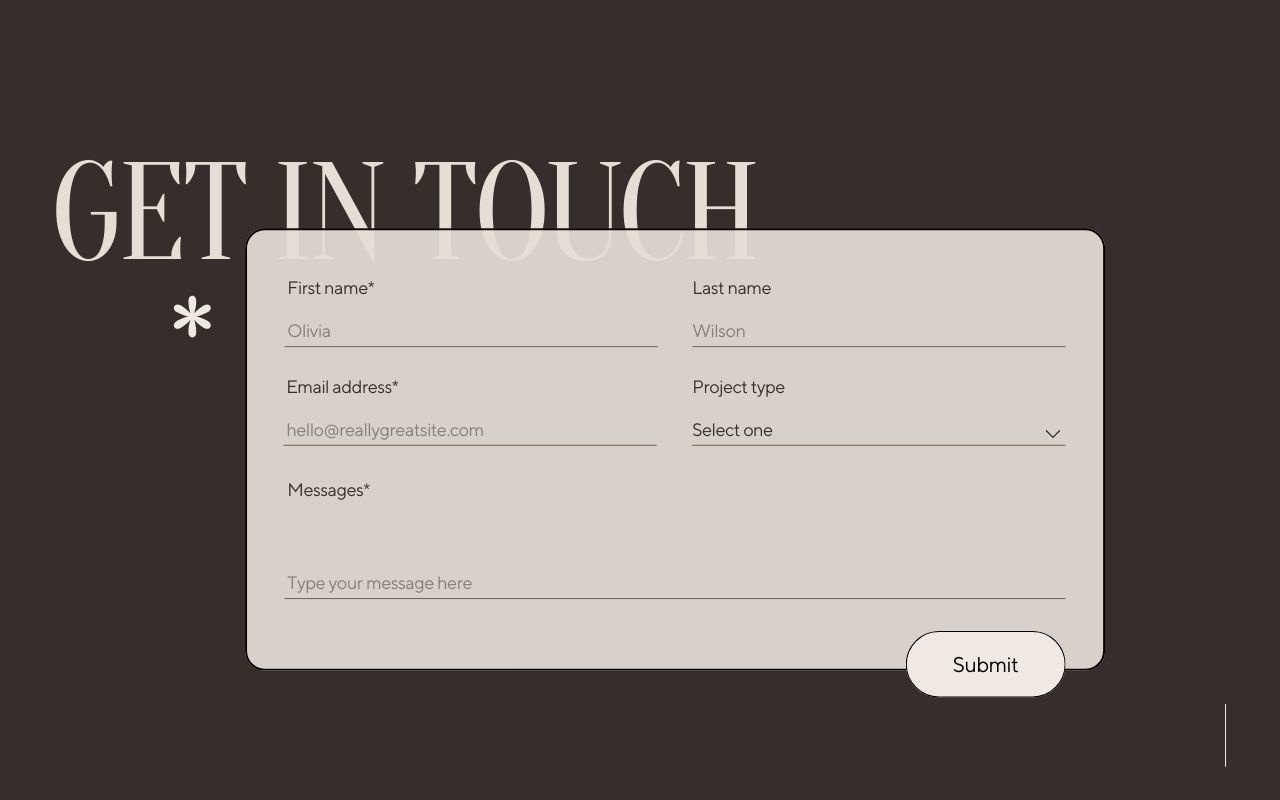
External Links for Further Reading and Resources
- Patent Databases for Prior Art Searches
- United States Patent and Trademark Office (USPTO): USPTO Patent Database
- European Patent Office (EPO) Espacenet: Espacenet Patent Search
- World Intellectual Property Organization (WIPO) PATENTSCOPE: WIPO PATENTSCOPE
- Educational Resources on Patent Law and Prior Art
- WIPO Academy: WIPO Academy for courses and resources on intellectual property.
- IPWatchdog: Articles on prior art and patent law are available at IPWatchdog.
- Landmark Legal Cases Involving Prior Art
- Articles and Publications on Prior Art
- Tools and Technologies for Prior Art Searches
- Overview of AI in Patent Searches: An insightful article on the use of AI for prior art searches on Artificial Lawyer.
- International Patent Law and Prior Art
- World Trade Organization - TRIPS Agreement: Information on the TRIPS agreement at WTO TRIPS.

